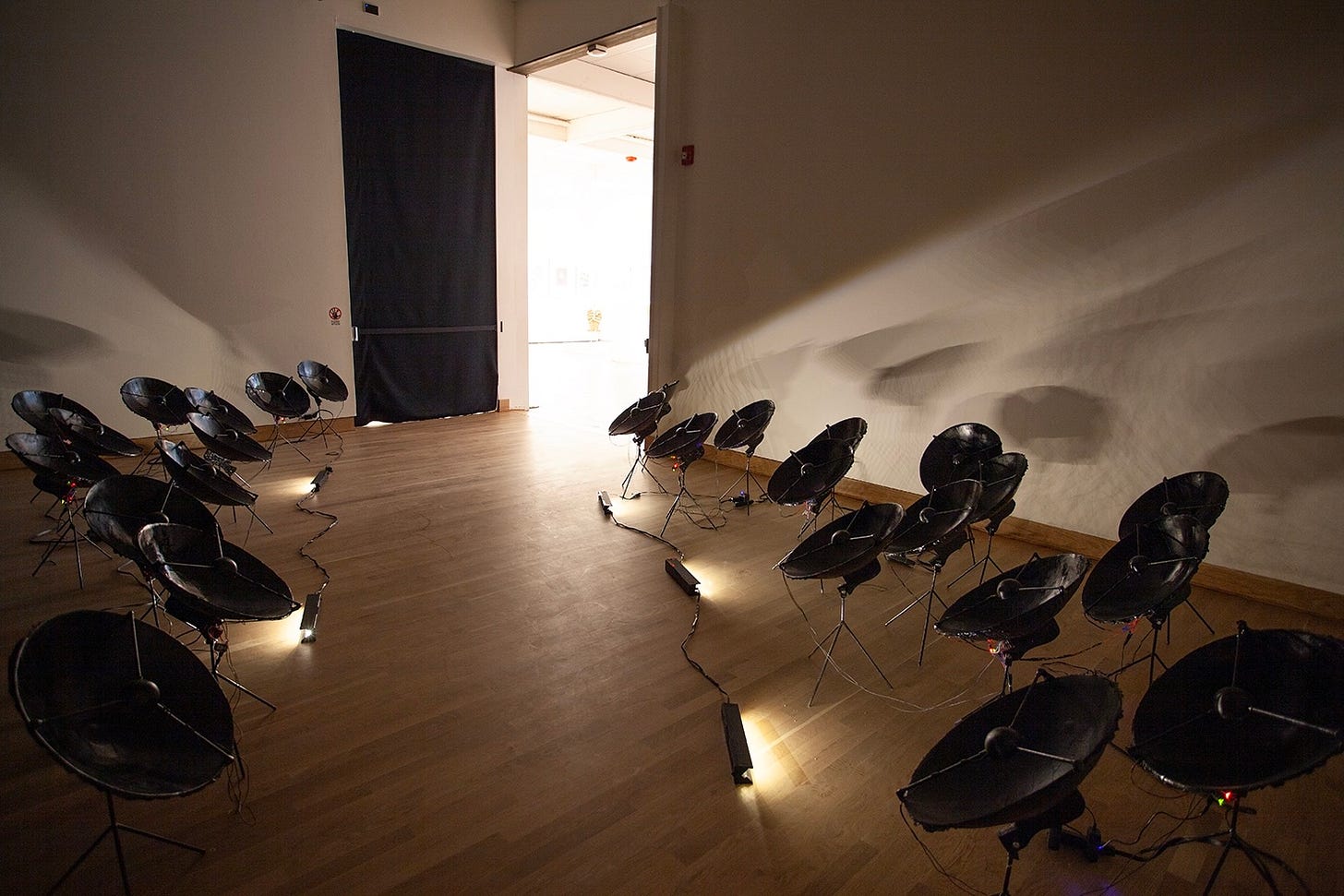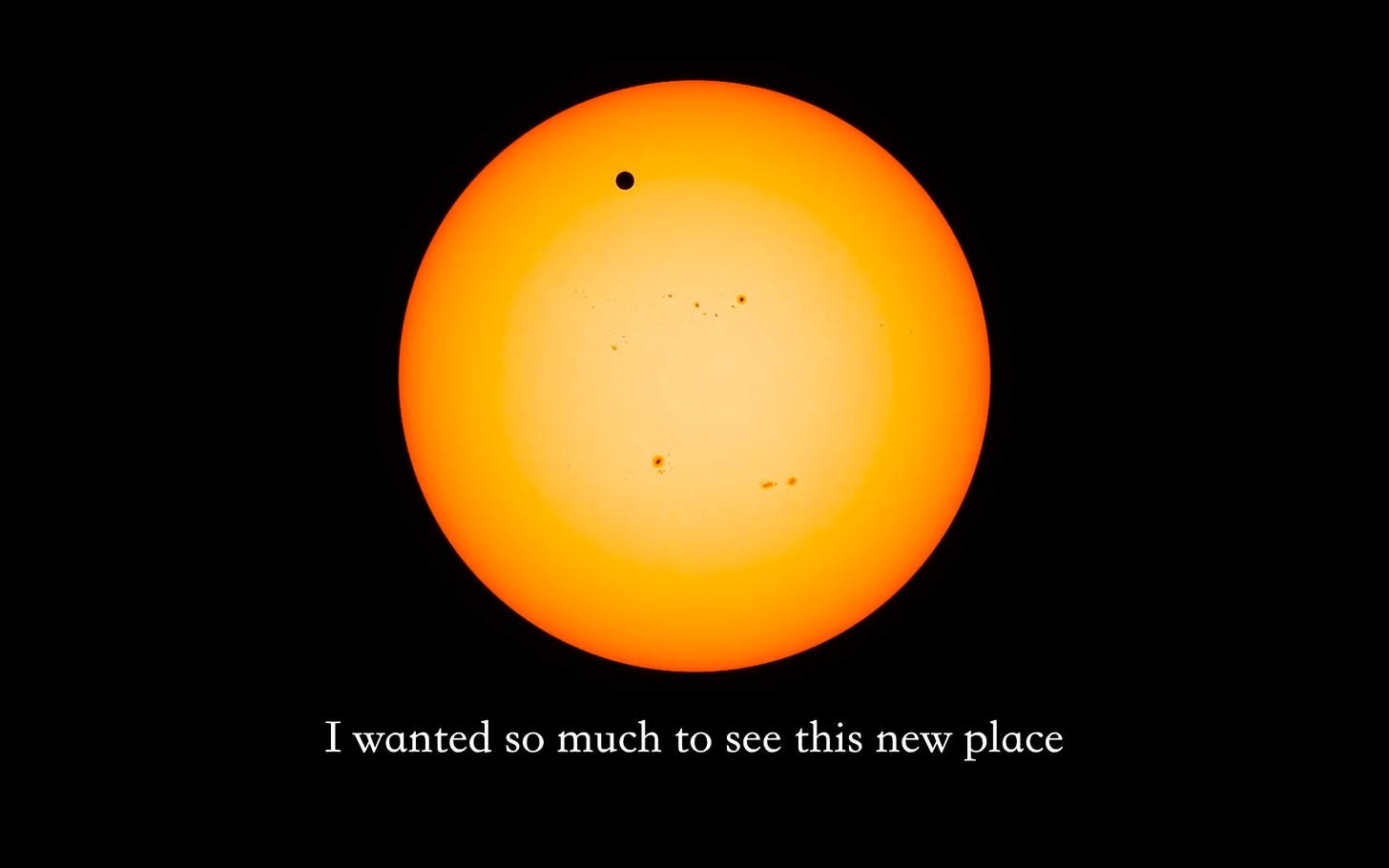there is no terra nullius
thoughts and art about the desert

In May of 2023, I moved from LA to Roswell, NM. I had never been to NM before, and wasn’t sure what to expect. The little I knew about the state had mostly to do with industry. For example, I had read how semiconductor manufacturing firms–which arose in Silicon Valley in the 1960s–moved some of their factories to NM in search of looser labor and environmental regulations.
I also knew that much of NM was desert. That said, I knew very little about deserts and so I pictured the place I would soon be calling home to be a barren, empty landscape. I imagined land that was dry and dusty and spotted with sprawling warehouses or industrial sites.
Driving down the I-40, the landscape changes. As you pass through Flagstaff, AZ, it’s as if the trees are sinking down into the earth and pulling the sky wider above them as they go. The ground itself changes from a light ochre to a chalky pink. I noticed the road becoming redder as I went west, dusted by the wind tumbling uninterrupted across the open land.
But what I saw as I drove wasn’t empty or barren. There were bushes and shrubs, birds and people. Even the dirt with its changing colors felt alive.
Over my first few days at the Roswell Artist-in-Residence compound, I explored my immediate surroundings tentatively. Outside my window was a field of knee-high grass and shrubs, with purple and yellow flowers dotted throughout. I saw that there was so much life and it was a revelation.


I don’t think my preconceptions about deserts are unique. The word ‘desert’ in English comes from the Latin word desertum meaning a “thing abandoned”. And of course the verb, to desert or deserted also means abandoned or left empty. So it’s no surprise that the word desert doesn’t bring to mind a vibrant, lively place.
But the disconnect between what deserts are in our collective, social imagination in the West versus what they actually are made me wonder about what purpose the image of an empty desert serves.
One third of the land on our planet is desert. And those desert regions are far from empty. They have rich, vibrant, and ancient ecosystems. And they are and have for millennia been home to humans.
However, in the West, the idea of a desert is far from the reality of the desert. The desert is seen as the opposite of civilization (El Guabli et al. 45). It is a place that has not yet been tamed or civilized, or it is what is left after civilization falls.
When you see the desert in this way, as empty, useless, and foreign, then it’s easier to accept, or even advocate for, its destruction.
Terra nullius refers to the legal designation of a place as empty and belonging to no one. This concept allows a nation to lawfully enter, occupy, and claim land considered 'empty.' Historically, European nations have invoked the idea of terra nullius to justify colonization and to lay claim to indigenous lands.
While terra nullius is not specific to desert regions, designating a space as empty is a rhetorical desertification of a place. Before you can claim something as empty legally, you first have to see it as empty, and the desert is land that’s been made empty in the collective imagination.
So then what? What happens when a place is deemed empty? What comes in to fill it?
Places that are seen as abandoned, like deserts, are not seen as in need of preservation. Rather, they are places that need to be made productive, making them vulnerable to colonization, extractive economies, and toxification. Deserts have been a destination for industrial manufacturing, toxic waste dumping, mining, weapons testing, and military and scientific facilities.
As someone interested in technology and its conflation with progress in Western culture, I find it particularly interesting that places perceived as empty, and deserts in particular, become sites for large-scale technological and scientific infrastructure: data centers, solar farms, spaceports, observatories. These infrastructure exist away from the majority’s sight. There is no attempt to hide them because there is no need. Their remoteness obscures them from view.
And even if they are easily visible, like the enormous solar farm off I-10 in AZ, technological and scientific infrastructure are a symbolic representation of optimism and progress. Unlike a weapons testing facility or a toxic waste dump, tech infrastructure is seen as a positive testament to human creativity and innovation. These are the infrastructure that power our digital lives (server farms), that will save us from an energy crisis of our own making (solar farms), and help us reach out to the stars (observatories).
Yet, their site and scale make them problematic. Server farms siphon water from drought stricken regions, solar farms damage the delicate desert ecosystem trapped in their shadow, and the voices of marginalized communities are pushed aside to build observatories.
However, the prevailing view is that the needs of the majority who live far from these sites outweigh the needs of the human and non-human inhabitants affected daily by their presence.
The lesson we can’t seem to learn is that technological solutions cannot solve social problems. So long as we think of deserts as empty places to develop or destroy as we wish, we will continue to create more ecological and social problems in deserts and elsewhere.
***
Even before arriving in Roswell, I had begun thinking about emptiness in relation to “out-there” space (the kind described as the final frontier). The cosmos outside our tiny planet is treated as the new terra nullius. But is it truly empty?
Early in my time in NM, I visited the Very Large Array. The array is located in the plains of St. Agustin, about an hour west of Albuquerque. It consists of 27 large radio antennas arranged along three arms. Each antenna is in the shape of a parabolic dish, which helps focus the radio signals it receives from space.

The drive to the array is along a long, one-lane road flanked by brush and low, rocky hills. As you get closer, the view opens up and you see a few huge dishes on the horizon. They look small from far away, like little creatures grazing out in the fields. As you get closer, you realize the scale of them. They are enormous.
The antennae track the whispers of stars and planets on the other side of our universe, listening to the ultimate empty space that is not really empty. (If space was empty there would be nothing to listen to!).
Similar to European colonists who arrived in places such as New Mexico, and declared it empty because they didn’t see what they recognized as civilization, would we recognize an alien civilization if we were to hear it? (Shorter & Tallbear 2021; Lempert 2021; Charbonneau 2021)
We describe space as empty not because there isn’t anything there, but because there isn’t anything or anyone there we consider important enough to stop us from doing what we want.
One proxy that scientists use to determine intelligence is technology. SETI, the search for extraterrestrial intelligence, searches for radio or other signals that sound or look intentional (Charbonneau 2021).
It’s anthropocentric to assume that alien civilizations would develop technology similar to ours. When colonists saw people with different lives, languages, and technologies, they decided they were uncivilized and that their lands were empty and free for the taking. (This is not to mention the fact that we Westerners tend not to recognize the intelligence of non-human beings.)
In contrast to the VLA, I wanted to create a place where we can listen to the space that is not empty right around us, and consider the different intelligences and civilizations of the non-human beings we share space with.
an array is an installation of 27 small parabolic dishes, inspired by the VLA. Each is playing a recording of local wildlife or other natural phenomena, such as thunderstorms.
The dishes have the same parabolic curve as the VLA dishes, except the sound is projected outwards unidirectionally rather than focused in. As you move past the dishes, the sounds become louder or quieter depending on your position relative to each one. If you stand directly in the path of the sound beam, the recordings will seem to be coming from somewhere right beside you.

When researching the VLA, I came across the story of the 1769 transit of Venus (Charbonneau 2021; Lempert 2021). Several Western colonial powers sent scientists to places around the globe in order to observe the transit in order to measure the distance between Earth and our sun. This measurement would improve the accuracy of navigation for long sea voyages, allowing colonial powers to further their reach.
This illustrates the historical precedent for the type of international scientific cooperation we see today between astronomers. While their interest might be pure scientific curiosity, the institutions and governments funding this research are pursuing the knowledge because of the potential for financial reward.
Among the ships sent to observe the transit was James Cook’s Endeavor. In addition to their orders to map the transit from Tahiti, the crew was given a second, secret set of instructions. They were to map and explore the fabled southern continent, a land mass thought to cover much of the southern hemisphere. While they did not find it (since it does not exist), they spent several years exploring Australia and New Zealand, declaring the land they saw as terra nullius and claiming them for England.
The transit of Venus is a video letter from Cook’s telescope to a present day solar observatory, specifically the Inouye telescope in Haleakalā, HI. In the letter, Cook’s telescope reflects on its role in the history of Western astronomy and colonialism.
The telescope is conflicted about the joy it finds in its work, specifically in seeing new places, versus how its contributions are used to further colonial interests. In the West, science is said to be objective and apolitical. It is done for the benefit of all mankind.
However, no scientific endeavor can be completely separated from the socio-political context it operates within. Historical and present-day scientific pursuits have directly facilitated imperial expansion and military conquest. It is naive for scientists to claim their work has no impact beyond sating their curiosity. As we’ve seen with Cook’s voyage, looking is never just looking (Shorter & Tallbear 2021). In a colonial context, looking is the first step towards claiming, and space is the new site of the colonial gaze.
Space offers what the so-called new world offered: empty lands available for colonization. Rich deposits of ore. A place to put heavy, toxic industrial production without consequence to “civilized” people.
Founder of Amazon Jeff Bezos has suggested moving heavy industry into space in order to protect our planet. Presumably, his reasoning is that there is nothing in space that might be damaged by the pollution associated with industrial production.
However, moving industry to the desert didn’t solve our issues, and it’s unlikely going to space will either. We’re already filling “empty” space to the point that we’re causing problems, and prioritizing the vanity of wealthy majoritarians in deciding what activities are allowed in space over the sacred beliefs of indigenous peoples.
The problems with terrestrial extraction and colonization are being replicated in a new setting. This underscores the importance of reflecting on the history of deserts and how they have been “made useful” by colonial powers.
One “useful” activity prevalent in desert regions is mining. As concerns about our planet’s limited resources grow, mining has become a key interest for advocates of space exploration. The future of technology and our economy depends on the future of mining. Circuit boards, displays, and touch screens contain gold, silver, palladium, indium, as well as many non-precious metals. Mining provides the raw materials foundational to modern day technology and industry.
Rather than examine the problems with our economy’s need for perpetual growth, proponents of space mining argue it is a way to sustain our current trajectory indefinitely. While I’m skeptical of the idea of infinite growth overall, there is also the immediate labor and environmental costs.
Humans will still be needed to build, maintain, and operate mining rigs, and pollution jettisoned into space may damage extra-terrestrial ecosystems.
The last piece in the show is a device for crushing ore. The shape and function of the piece is based on an arrastra, which was a device used by early miners looking for gold, silver, and other precious metals. I was fascinated by the movement and sound of the machine, it was like an injured titan dragging itself in circles and groaning. A device for crushing ore calls back to the history of mining, while the grotesque and bone-like arm is a reminder of the human element in the machine.


There is little evidence that our mindset today is different from European colonists who arrived in places such as New Mexico and declared it empty because they didn’t see what they recognized as civilization. What’s certain is that space exploration and colonization orchestrated by a civilization built on exploitation, extraction, and destruction will bring more of the same.
This is not to say space exploration is impossible. I am an optimist. I very much want to go to space myself. I believe it’s possible to meet other species, civilizations, and ecosystems and have the meeting be a space for mutual exchange and learning. But first we have to stop thinking of empty space as empty, and instead to see, appreciate, and respect the fullness that is already there.
More images and videos of the show are available on my website.
Bibliography
Brenckle, Matthew. “Clothing the Royal Navy Sailor, 1765 to 1775.” Newport Historical Society, newporthistory.org/wp-content/uploads/2018/10/clothingstandards-1765-1775royalnavy.pdf.
Charbonneau, Rebecca. “Mixed Signals: Communication with the Alien in Cold War Radio Astronomy.” University of Cambridge, 2021.
Charbonneau, Rebecca. “Imaginative cosmos: The impact of colonial heritage in radio astronomy and the search for extraterrestrial intelligence.” American Indian Culture and Research Journal, vol. 45, no. 1, 2021, pp. 71–94, https://doi.org/10.17953/aicrj.45.1.charbonneau.
El Guabli, Brahim, et al. “Desert Futures Collective: a conversation with Brahim El Guabli, Jill Jarvis, and Francisco E. Robles.” Interview by Samia Henni. Deserts Are Not Empty. Columbia University, 2022. pp. 25-48.
Geisler, C. “New Terra Nullius Narratives and the Gentrification of Africa’s ‘Empty Lands’”. Journal of World-Systems Research, vol. 18, no. 1, Feb. 2012, pp. 15-29, doi:10.5195/jwsr.2012.484.
Home, R. W. “The Royal Society and the Empire: The Colonial and Commonwealth Fellowship. Part 1. 1731-1847.” Notes and Records of the Royal Society of London, vol. 56, no. 3, 2002, pp. 307–32. JSTOR, http://www.jstor.org/stable/3557735.
Inouye Solar Telescope primary mirror. National Solar Observatory, https://nso.edu/gallery/gallery-dkist/#foobox-1/26/IMG_0776.jpeg.
Lempert, William. “From interstellar imperialism to celestial wayfinding: Prime directives and colonial time-knots in Seti.” American Indian Culture and Research Journal, vol. 45, no. 1, 2021, pp. 45–70, https://doi.org/10.17953/aicrj.45.1.lempert.
Shorter, David Delgado, and Kim TallBear. “An introduction to settler science and the ethics of contact.” American Indian Culture and Research Journal, vol. 45, no. 1, 1 Jan. 2021, pp. 1–8, https://doi.org/10.17953/aicrj.45.1.shorter_tallbear.





Would be interested in your thoughts about Antarctica
finders,keepers.